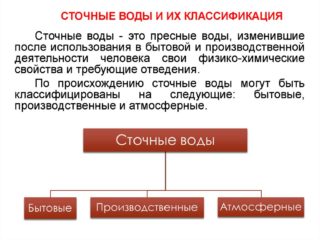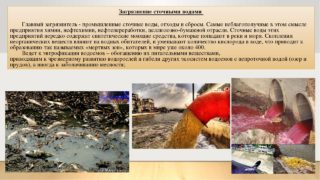According to the definition given by GOST, wastewater is liquids that contain pollutants in the form of household and industrial waste. In order to clean them and remove them from urban, settlement territories and areas of enterprises, they equip sewerage systems and treatment facilities.
Classification and composition of wastewater
- Household (household fecal). They get into the sewer network from plumbing fixtures. The formation of such drains occurs both in residential, public and industrial premises in the course of human life. They represent the greatest danger, since they contain a significant amount of organic impurities that are prone to decay. These include excrement, urine and various microorganisms, including pathogens.
- Rainy or superficial. Appear on roads, squares, roofs after precipitation. This category also includes runoff from watering gardens and lawns. They are considered the cleanest and contain a small amount of organic matter and mineral suspensions.
- Manufacturing. They arise during the implementation of various processes of the technological plan with the use of water at industrial facilities.
The last category is divided into two types: polluted wastewater, for which purification is required before reuse or release to water bodies, and relatively clean, not requiring pretreatment. Hazardous substances in the composition differ and entirely depend on the industry and technological features of production.
Another classification of wastewater is based on the concentration of harmful impurities, aggressiveness and toxicity. According to her, sewage is divided into four types:
- slightly contaminated;
- moderately polluted;
- heavily contaminated
- dangerous.
The main evaluation criterion is pH. Slightly aggressive liquids include weakly acidic with pH = 6–6.5 and slightly alkaline compositions with pH = 8–9. Liquid media with a strongly acidic (pH <6) or strongly alkaline (pH> 9) composition are highly aggressive.
Also, contaminated waters are separated by phase-dispersed composition into suspensions, colloidal, molecular and ionic solutions.
The classifications are regulated by the norms of SanPiN and federal laws, in particular the Water Code.
Assessment of the degree of pollution
Since industrial and household wastewaters have a complex composition, it is extremely difficult to quickly identify and assess the concentration of each of the pollutants.
In this regard, when conducting urgent analyzes, those criteria are selected that are able to characterize the total properties of water without recognizing impurities separately. For example, when evaluating organoleptic data, the selection of each of the impurities that color or impart an odor is not performed. To determine the composition, a total sanitary-chemical study of sewage wastewater is used. It includes chemical, physical-chemical and microbiological tests.
When performing a complete sanitary-chemical analysis, an assessment is carried out according to the following indicators:
- acidity level (pH), dry residue, presence of suspended matter;
- temperature, smell, color, transparency;
- biochemical oxygen demand (BOD5) - consumption of this element for five days;
- the presence of heavy metals, radioactive and toxic substances;
- the presence of petroleum products, surfactants, dissolved oxygen;
- concentration of phosphates, sulfides, nitrogenous compounds, chlorides;
- determination of the microbial number, microorganisms of the Escherichia coli group, parasites.
The technique of measuring the mass concentrations of ethylene glycol and diethylene glycol in samples of natural and sewage liquids by gas chromatography is also used.
Research allows you to assess the effluent in terms of maximum permissible indicators. Their meanings are as follows:
- the number of substances announced - 500;
- BOD - 500;
- COD - 800;
- the remainder of dense matter - 2000;
- ether-containing impurities - 20.
In addition to standard tests, additional tests can be carried out at city-wide wastewater treatment plants. They make it possible to determine the composition and degree of contamination of industrial wastewater discharged from local industrial complexes.
Main types of pollutants
The composition of waste fluids is determined by the presence of pollutants in them:
- biological;
- chemical;
- mineral.
The first include microbes (viruses and bacteria), yeast and algal cultures, fungi and vegetation. Polluting chemical impurities are refined products, surfactants, pesticides, heavy metals, dioxins, phenols, nitrogen compounds. Earth, slag, sand, silt are impurities of a mineral nature.
Conservative and non-conservative contaminants are also emitted in liquids. The former do not enter into chemical reactions, do not decompose during biological purification. Non-conservative impurities are removed from the effluent by means of self-cleaning bioprocesses.
Danger of untreated waste water
- absorption of the oxygen component;
- significant decline in water quality;
- settling of hazardous components to the bottom;
- the inability to use water even for technical purposes;
- death of aquatic inhabitants due to the destruction of their natural habitat.
All types of sewage fluids reduce the functionality of natural and man-made sources. For this reason, most of them cannot be bathed, they are not suitable for recreation or the use of water. To prevent problems, it is important to purify wastewater from pollution.
Industrial effluents are capable of carrying not only a chemical, but also a bacteriological hazard. This is possible if the discharge comes from leather processing plants, slaughterhouses, medical industries. Even anthrax bacteria, the causative agents of glanders, can get into the water. Also, without cleaning, industrial waste is a source of aggressive chemicals.
Among domestic sewage fluids, black wastewater is considered the most dangerous. They account for about 25 percent of the total volume of domestic sewage, they include a lot of organic matter and bio-pollutants. These sewage fluids contain more than half of the total amount of phosphorus, about 80 percent of nitrogenous compounds (including urea) and almost all fecal bacteria. It is these components of drainage, in addition to aggressive chemistry, that are the main threat to water resources.
Substances of a biological and chemical nature should not get into the ground or water body.If your pipeline is connected to a citywide sewer, sanitation is a utility problem. If the connection is not made, you are responsible for the safety of faecal discharges or disposal of liquid waste to city sewage treatment plants. It is for these purposes that septic tanks and biological treatment stations are being equipped.
Septic devices are not always capable of completely disinfecting household waste. For antibacterial effects on liquids, ultraviolet radiation or ozonation is used. Such disinfection is required if the water is supposed to be reused for technical needs. Industrial effluents may require the use of physicochemical and chemical treatment methods.











